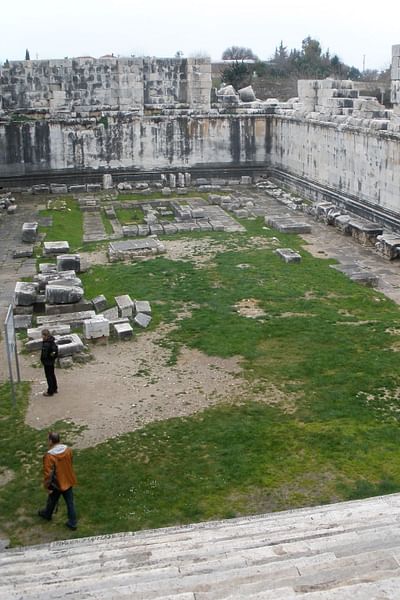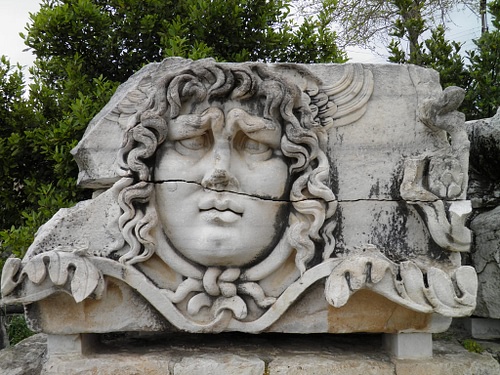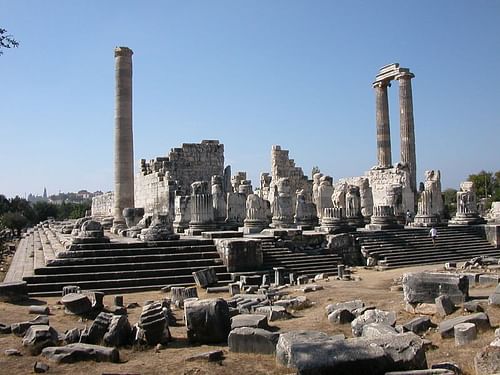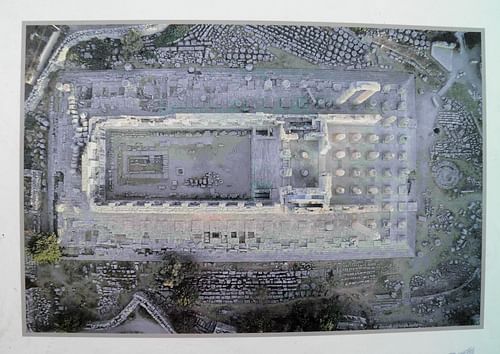Located about 11 miles south of the ancient port city of Miletus on the western coast of modern-day Turkey, the Temple of Apollo at Didyma or Didymaion was the fourth largest temple in the ancient Greek world. The temple's oracle, second in importance only to that at Delphi, played a significant role in the religious and political life of both Miletus and the greater Mediterranean world; many rulers, from Alexander the Great (356-323 BCE) to the Roman emperor Diocletian (244-313 CE) visited or sent delegations to this oracle seeking the guidance and favor of Apollo. The oracle played a significant role in initiating the “Great Persecution” of Christians under Diocletian and the temple was later converted into a church during the 5th or 6th century CE.
The Didymaion was the third and largest temple that the Greeks built around the site of a natural spring, which they believed to be the source of the oracle's prophetic power. The first temple was a humble structure that replaced a much earlier Carian sanctuary. In the 6th century BCE the people of nearby Miletus began construction on a second, much larger temple. Wider than and as long as the Parthenon in Athens, this second temple reflected the growing fame and influence of the oracle. This temple, however, was plundered and destroyed, either in 494 BCE by the Persian king Darius or in 479 BCE by his son and successor Xerxes. Legend has it that the sacred spring ceased to flow until none other than Alexander the Great passed through on a conquest of his own and re-consecrated the site in 331 BCE. Not surprisingly, the first recorded pronouncements of the reestablished oracle were in favor of the young Macedonian king.
While Alexander reopened the site at Didyma, his siege left Miletus heavily damaged and the tariffs levied against the citizens as punishment for their resistance financially crippled the city for decades. When Miletus finally began to recover - some thirty years after Alexander's conquest - the citizens began construction on yet another temple at the site of the sacred spring. It is this third and final temple that is known today as the Temple of Apollo at Didyma or the Hellenistic Didymaion. As was common for Greek temples of such an immense size, construction continued for centuries and the temple was never completed; even in the late 4th century CE the temple lacked a pediment or a cornice and much of the sculptural ornamentation and even several of the massive columns remained unfinished. Nevertheless, the temple must have been a magnificent sight as even the ruins can leave the modern-day visitors awestruck.
The Hellenistic Didymaion
The Milesians designed the Hellenistic Didymaion to rival the largest temple in the Greek world - the nearby Temple of Artemis at Ephesus, one of the seven wonders of the ancient world. The Didymaion was indeed larger in some respects while smaller in others, but both temples were well over twice the size of Athens' Parthenon. Like the Temple of Artemis, the Didymaion was built to resemble from the outside an ordinary, albeit enormous, Greek temple. The Didymaion possessed an enormous temple platform or podium that created a level building area of over 5,500 square meters. Upon this raised platform rested 122 massive columns, each 2.5 meters in diameter, that in turn supported an elaborate coffered roof that extended out over the entire platform. In its nearly finished state, the walls of the temple rose to a towering height of nearly 28 meters above the ground.
While the exterior of the Didymaion appeared similar to an ordinary Greek temple, the interior was quite unique. The inner chamber or adyton of a traditional Greek temple was built directly on top of the temple platform or podium. The temple at Didyma, however, was built around a sacred spring and so the floor of the adyton had to be at ground level. The architects of the Didymaion came up with an ingenious solution; they constructed two long and narrow vaulted tunnels, each over 21 meters long and just over 1 meter wide, that led from the top of the temple platform back down to the grassy floor of the adyton. This clever “hollow” design allowed the Milesians to build a traditional-looking temple that rivaled the Artemision in Ephesus while also preserving the natural spring that had long been considered the sacred source of the oracle's power. Moreover, while from the outside the temple appeared fully roofed, the inner chamber of the Didymaion was open to the sky. This allowed the temple staff to cultivate a grove of sacred trees on the adyton floor. In this idyllic environment, amidst the trees and beside the sacred spring, stood a much smaller temple or naiskos that held the cult statue of Apollo.

The Political & Religious Significance of the Didymaion
In a world where “church and state” were inseparable, the Temple of Apollo at Didyma played a critical role in the religious and political life of ancient Miletus. The temple complex served as the site of important religious festivals, sacrifices, and votive offerings while the oracle exercised a significant influence on Milesian civic statutes, treaties, public enterprises, and was relied upon to provide protection against enemies and to help direct public and foreign affairs (Fontenrose, 105).
The importance of the site meant that the office of the high priest (not to be confused with the oracle), whose job it was to preside over the sanctuary, was an immensely powerful and highly sought after position. Elected and limited to a one-year term, high priests were often “aristocratic gentlemen of Miletus, [who were] deeply involved in the politics and trade of that city…and whose clearest responsibility was to finance numerous activities associated with the sanctuary” (Robinson, 12). In fact, this office was so prestigious and the sanctuary so crucial to the religious and political affairs of Miletus and the larger Mediterranean that numerous Roman emperors, including Trajan, Hadrian and Julian, were “elected” (i.e. appointed themselves) to this position. The emperors were far more interested in obtaining the honorific title than actually performing the duties, which they left to someone else entirely. Nevertheless, they did contribute significant resources to the continued construction and maintenance of the sanctuary. Both Julius Caesar and Caligula served as patrons of the sanctuary. Trajan constructed a new Sacred Way connecting the temple complex to Miletus that was later repaired by the emperor Julian in 359 CE as part of his effort to revitalize traditional Greco-Roman religious traditions. The emperors' patronage of this site underscores both the temple's unfinished state as well as the fact that this massive sanctuary continued to exercise an immense amount of influence on the religious and political affairs of the Mediterranean world well into the later years of the Roman Empire.

The Didymaion in Late Antiquity
While almost every western emperor from Caesar to Julian consulted the oracle at Didyma, the most famous (or notorious) instance took place in 303 CE, during the reign of the emperor Diocletian. According to Lactantius' De mortibus persecutorum, Diocletian sent a delegation to Didyma to ask the oracle what he should do about the growing number of Christians within the empire and the widespread complaints that Christians were upsetting the gods; even the citizens of Miletus had complained that Christians had taken up residence outside the temple at Didyma and that their heretical religion was “preventing accurate prophecies” (Digeser, 57). According to Lactantius, the oracle's response (which is itself lost to history) inspired Diocletian to launch the most severe and systematic persecution of Christians in Roman history.
Although the sanctuary continued to function well into the 4th and perhaps even the 5th century CE, the oracle's role in the “Great Persecution” was not soon forgotten. During the 5th and 6th centuries CE, when the vast majority of Greek and Roman temples were simply abandoned and left to crumble away, the Didymaion was singled out for Christian reuse; a small three-aisled basilica was built deep within the adyton of the temple. Because of the Didymaion's unique design, the Christian reuse of this site stands out from other examples of temple appropriation. Most surviving examples of this otherwise rare phenomenon (the vast majority of “pagan” temples were simply abandoned and left to decay over time) suggest that Christians preferred to build churches where they were highly visible - on the very edge of the temple's platform - and avoided altogether the main central rooms of the former temple (Hahan, 12). In nearby Aphrodisias, for example, Christians built a church that completely engulfed the platform of the ancient Temple of Aphrodite. Since the temple was the focal point of the entire city, the church was highly visible and made a powerful statement about the ascendancy of the Christian community. This type of appropriation, however, was simply not possible at Didyma since the Didymaion only gave the appearance of having a traditional platform on which a church could be built. Nevertheless, the Christian community built their church on the unpaved adyton floor where it was completely invisible to people passing by outside the ancient temple.
Reconstruction
Unfortunately, little more can be said of this church since German archaeologists in the early 20th century CE hastily removed all remains of this church with little documentation in an effort to restore the temple to its Hellenistic form (see Wiegand). It is worth considering, however, that the reason for the construction of this basilica in such a location had less to do with the oracle's role in the “Great Persecution” and more to do with the temple's association with the god Apollo. Numerous scholars have demonstrated that Christians were fond of drawing parallels between Apollo as the inspiration for pagan prophecy and Christ as the source of Christian prophecy (Kerkeslager, 119). Perhaps the appropriation of this oracular sanctuary indicates that local Christians, like the Romans, the Greeks, and the Carians before them, also held the natural spring to be a source of prophecy that only needed to be purified or sanctified through proper Christian ritual; it is particularly interesting to note that it was beside this same spring that the Christians built a baptistery with which to initiate new members.










